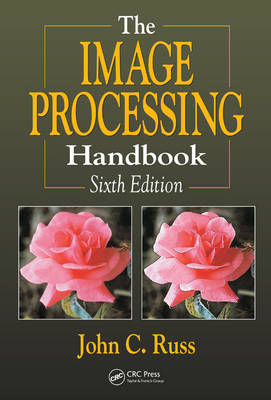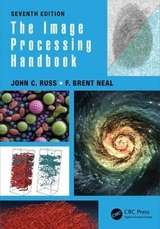
The Image Processing Handbook, Sixth Edition
Crc Press Inc (Verlag)
978-1-4398-4045-0 (ISBN)
- Titel erscheint in neuer Auflage
- Artikel merken
Whether obtained by microscopes, space probes, or the human eye, the same basic tools can be applied to acquire, process, and analyze the data contained in images. Ideal for self study, The Image Processing Handbook, Sixth Edition, first published in 1992, raises the bar once again as the gold-standard reference on this subject. Using extensive new illustrations and diagrams, it offers a logically organized exploration of the important relationship between 2D images and the 3D structures they reveal.
Provides Hundreds of Visual Examples in FULL COLOR!
The author focuses on helping readers visualize and compare processing and measurement operations and how they are typically combined in fields ranging from microscopy and astronomy to real-world scientific, industrial, and forensic applications. Presenting methods in the order in which they would be applied in a typical workflow—from acquisition to interpretation—this book compares a wide range of algorithms used to:
Improve the appearance, printing, and transmission of an image
Prepare images for measurement of the features and structures they reveal
Isolate objects and structures, and measure their size, shape, color, and position
Correct defects and deal with limitations in images
Enhance visual content and interpretation of details
This handbook avoids dense mathematics, instead using new practical examples that better convey essential principles of image processing. This approach is more useful to develop readers’ grasp of how and why to apply processing techniques and ultimately process the mathematical foundations behind them.
Much more than just an arbitrary collection of algorithms, this is the rare book that goes beyond mere image improvement, presenting a wide range of powerful example images that illustrate techniques involved in color processing and enhancement. Applying his 50-year experience as a scientist, educator, and industrial consultant, John Russ offers the benefit of his image processing expertise for fields ranging from astronomy and biomedical research to food science and forensics. His valuable insights and guidance continue to make this handbook a must-have reference.
Now retired from the Materials Science and Engineering Department at North Carolina State University, Raleigh, USA, Dr. John C. Russ has worked with many different types of microscopes and image analysis tools to study the microstructure of materials. During a career of nearly 50 years teaching students and working in industry, he has become recognized worldwide as an expert in image analysis. He has developed a familiarity with other types of microstructures and corresponding fields, including foods, biological materials, , wood and paper products, textiles, and biomedical and forensic imaging. He has published numerous books and papers, and continues to teach workshops, consult on imaging issues, and provide expert witness testimony. Dr. Russ is the recipient of the Ernst Abbe Memorial Award from the New York Microscopical Society for his achievements in the field of microscopy.
Acquiring Images
Human reliance on images for information
Video cameras
CCD cameras
Camera artifacts and limitations
Color cameras
Camera resolution
CMOS cameras
Focusing
Electronics and bandwidth limitations
Pixels
Gray scale resolution
Noise
High depth images
Color imaging
Digital camera limitations
Color spaces
Color correction
Color displays
Image types
Range imaging
Multiple images
Stereoscopy
Imaging requirements
Human Vision
What we see and why
Recognition
Technical specs
Acuity
What the eye tells the brain
Spatial comparisons
Local to global hierarchies
It’s about time
The third dimension
How versus What
Seeing what isn’t there, and vice versa
Image compression
A world of light
Size matters
Shape (whatever that means)
Context
Arrangements must be made
Seeing is believing
Printing and Storage
Printing
Dots on paper
Color printing
Printing hardware
Film recorders
Other presentation tools
File storage
Storage media
Magnetic recording
Databases for images
Browsing and thumbnails
Lossless coding
Reduced color palettes
JPEG compression
Wavelet compression
Fractal compression
Digital movies
Correcting Imaging Defects
Contrast expansion
Noisy images
Neighborhood averaging
Neighborhood ranking
Other neighborhood noise reduction methods
Defect removal, maximum entropy and maximum likelihood
Nonuniform illumination
Fitting a background function
Rank leveling
Color images
Non-planar views
Computer graphics
Geometric distortion
Alignment
Interpolation
Morphing
Image Enhancement in the Spatial Domain
Contrast manipulation
Histogram equalization
Local equalization
Laplacian
Derivatives
Finding edges with gradients
More edge detectors
Texture
Fractal analysis
Implementation notes
Image math
Subtracting images
Multiplication and division
Principal Components Analysis
Other image combinations
Processing images in Frequency Space
About frequency space
The Fourier transform
Fourier transforms of simple functions
Frequencies and orientations
Preferred orientation
Texture and fractals
Isolating periodic noise
Selective masks and filters
Selection of periodic information
Convolution
Deconvolution
Noise and Wiener deconvolution
Template matching and correlation
Autocorrelation
Segmentation and Thresholding
Thresholding
Automatic settings
Multiband images
Two-dimensional thresholds
Multiband thresholding
Thresholding from texture
Multiple thresholding criteria
Textural orientation
Region boundaries
Conditional histograms
Boundary lines
Contours
Image representation
Other segmentation methods
The general classification problem
Processing Binary Images
Boolean operations
Combining Boolean operations
Masks
From pixels to features
Boolean logic with features
Selecting features by location
Double thresholding
Erosion and dilation
Opening and closing
Isotropy
Measurements using erosion and dilation
Extension to gray scale images
Morphology neighborhood parameters
Examples of use
Euclidean distance map
Watershed segmentation
Ultimate eroded points
Skeletons
Boundary lines and thickening
Combining skeleton and EDM
Global Image Measurements
Global measurements and stereology
Surface area
ASTM Grain Size
Multiple types of surfaces
Length
Thickness
Sampling strategies
Determining number
Curvature, connectivity and the Disector
Anisotropy and gradients
Size distributions
Classical stereology (unfolding)
Feature-Specific Measurements
Brightness measurements
Determining location
Orientation
Neighbor relationships
Alignment
Counting
Special counting procedures
Feature size
Circles and ellipses
Caliper dimensions
Perimeter
Characterizing Shape
Describing shape
Dimensionless ratios
Fractal dimension
Harmonic analysis
Topology
Three dimensions
Feature Recognition and Classification
Template matching and cross-correlation
Parametric description
Decision points
Multidimensional classification
Learning systems
kNN and cluster analysis
Expert systems
Neural nets
Syntactical models
Tomographic Imaging
More than two dimensions
Volume imaging vs. sections
Basics of reconstruction
Algebraic reconstruction methods
Maximum entropy
Defects in reconstructed images
Beam hardening
Imaging geometries
Three-dimensional tomography
High resolution tomography
3D Image Visualization
Sources of 3D data
Serial sections
Optical sectioning
Sequential removal
Stereo measurement
3D data sets
Slicing the data set
Arbitrary section planes
The use of color
Volumetric display
Stereo viewing
Special display hardware
Ray tracing
Reflection
Surfaces
Multiply connected surfaces
Image processing in 3D
Measurements on 3D images
Imaging Surfaces
Producing surfaces
Imaging surfaces by physical contact
Noncontacting measurements
Microscopy of surfaces
Surface composition imaging
Processing of range images
Processing of composition maps
Data presentation and visualization
Rendering and visualization
Analysis of surface data
Profile measurements
The Birmingham measurement suite
Topographic analysis and fractal dimensions
| Erscheint lt. Verlag | 19.4.2011 |
|---|---|
| Zusatzinfo | 137; 17 Tables, color; 1963 Illustrations, color |
| Verlagsort | Bosa Roca |
| Sprache | englisch |
| Maße | 178 x 254 mm |
| Gewicht | 2018 g |
| Themenwelt | Informatik ► Grafik / Design ► Digitale Bildverarbeitung |
| ISBN-10 | 1-4398-4045-8 / 1439840458 |
| ISBN-13 | 978-1-4398-4045-0 / 9781439840450 |
| Zustand | Neuware |
| Haben Sie eine Frage zum Produkt? |
aus dem Bereich



